EtherCAT(Direct Mode) "Online" tab:
The EtherCAT(Direct Mode) is a Real Time Ethernet Device that only supports the EtherCAT protocol. Internally it uses the same network drivers as the standard Real-Time Ethernet device (see Ethernet Miniport (Real-Time)) . Install instructions for the network drivers can be viewed under Appendix C. The EtherCAT (Direct Mode) device should be used, if only EtherCAT slave devices are connected to the network adapter. It offers additional features not available in the standard Real-time Ethernet device. If you scan for the device, at least one EtherCAT slave device should be connected to the device, otherwise the Rt-Ethernet device is selected. To change the device type from Real-Time Ethernet device to EtherCAT(Direct Mode), you have to open the context menu of the device in the System Manager tree view. Then you have to select the menu entry "Change To/ EtherCAT(Direct Mode)":
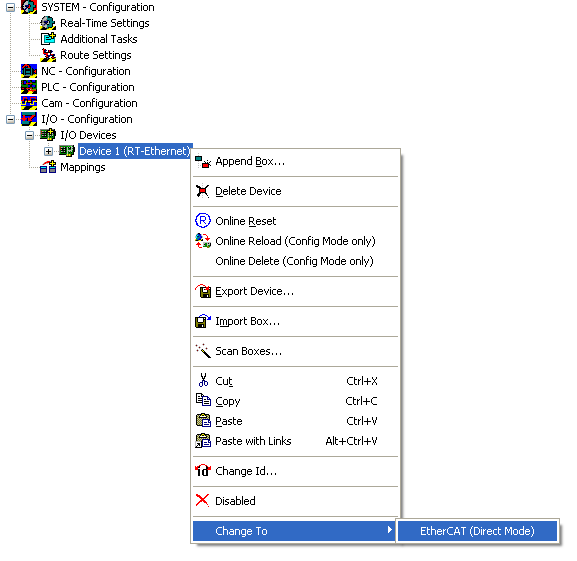
EtherCAT(Direct Mode) "Adapter" tab
After adding an EtherCAT(Direct Mode) to the I/O configuration, the following "Adapter" tab is available on the right:
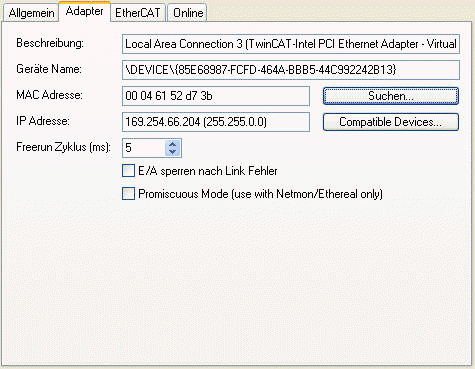
The Ethernet adapter currently selected is shown on this "Adapter" tab.
Search...: Looks for TwinCAT Real-Time Ethernet compatible devices and displays them.
MAC Address: MAC Address of this Ethernet controller
IP Address: Settings taken from Windows Registry. These can be changed under "Control Panel | Network Connections" in the TCP/IP 'Properties..' section.. If Real-Time Ethernet and "normal" Ethernet are both used on the same system with two different network adapters, the subnet addresses of these adapters (NICs) must differ! Nevertheless, the Real-Time Ethernet belonging devices have to be configured with the same subnet address (first two quadruples) as the Ethernet Miniport adapter and vice-versa, of course.
Freerun Cycle: The cycle time used if Free-Run is active (Config Mode only), can be set here. The cycle time in Run mode results automatically in reference to the task with the highest priority linked to the variables of the adapter or one of its nodes.
Lock I/O after Link Error: If this box is checked, the process data exchange doesn't resume automatically after a resolved link problem (e.g. when the network cable has been unplugged). In such a situation, an I/O Reset is necessary afterwards, instead.
Promiscuous Mode(use with Netmon/Ethereal only): This check box should only be enabled, if one wants to capture the network traffic with tools like Ethereal or the Microsoft Network monitor. If this box is checked, the Real-Time Ethernet miniport device copies all frames to the NDIS protocol layer of windows. This allows protocol drivers to capture the frames.
EtherCAT(Direct Mode) "EtherCAT" tab:
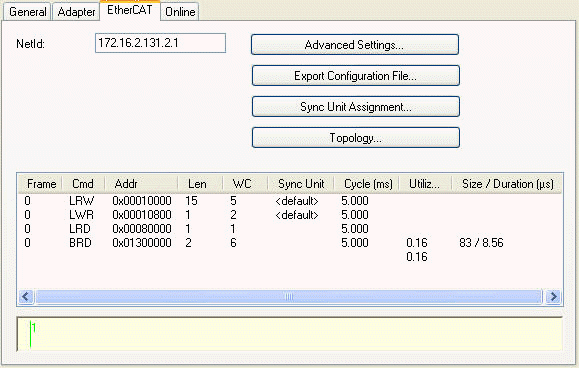
NetId: This is the NetId of the EtherCAT master device. The NetId is a parameter necessary for communicating with the EtherCAT master device via ADS. The ADS port of the EtherCAT master is always 0xFFFF(65535) and the Ads Port of an EtherCAT slave device is equal to the fixed address (see EtherCAT Addr) of the slave.
Advanced Settings...: Opens the Advanced Settings Dialog. This dialog contains additional settings for the EtherCAT master device.
Export Configuration File...: Creates the XML Master Configuration file. This file describes the process data and the frames sent during the EtherCAT state transitions.
Sync Unit Assignment...: Opens the "Sync Unit Assignment" dialog. This dialog can be used to group EtherCAT slave devices into separate sync units.
Topology...: Opens the "Topology" dialog. This dialog displays the topology of the configured EtherCAT slave devices.
The list view at the bottom displays all cyclic EtherCAT commands sent by the EtherCAT master:
Column | Description |
|---|---|
Frame | The cyclic frame the EtherCAT command is contained in. One EtherCAT frame can contain one or more EtherCAT commands. |
Cmd | The type of the command. |
Addr | Address of the data section of the EtherCAT slave devices this command addresses. If the EtherCAT command uses logical addressing (LRW, LW or LR) "Addr" specifies the logical address. Otherwise the upper 16 Bit always specifies the physical memory address and the lower 16 Bits either the fixes address of the device (see EtherCAT Addr) or the auto increment address of the device (see Auto Inc Addr dependent on the type of the command.) |
Len | Length of the data section. |
WC | Expected working counter. Each EtherCAT slave that is addressed by an EtherCAT command increments the working counter. If it is a Logical Read Write(LRW) command each EtherCAT slave device data is written to increases the working counter by 2 and each EtherCAT slave data is read from increases the working counter by 1. |
Sync Unit | Sync Unit the EtherCAT command belongs to. |
Cycle Time(ms) | Cycle time with which the frame is sent. |
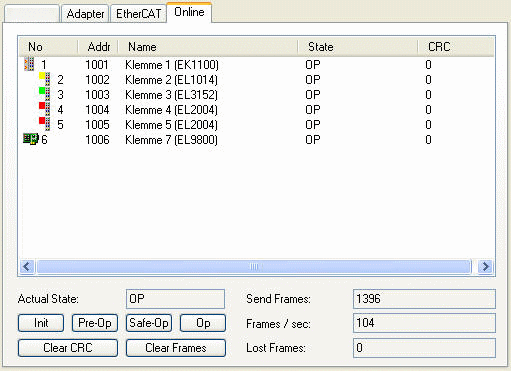
Actual State: Shows the current state of the EtherCAT master device.
Send Frames: Shows the number of frames sent by the EtherCAT master device.
Frames: Shows the number of sent frames per second.
Init: Requests the 'Init' state from the master.
Pre-Op: Requests the 'Pre-Op' state from the master.
Safe-Op: Requests the 'Safe-Op' state from the master.
Op: Requests the 'Op' state from the master.
Clear CRC: Clears the CRC counters of the EtherCAT slave devices.
ClearFrames: Resets the counter displayed in the "Send Frames" edit box to 0.
The list view shows all the EtherCAT slave devices and their corresponding states and CRC counters:
Column | Description |
|---|---|
No | Physical position of the device in the communication ring |
Addr | Fixed address (see EtherCAT Addr) of the slave device. |
Name | Name of the EtherCAT device |
State | State of the EtherCAT slave device. The state can be either INIT, PRE-OP, SAFE-OP or OP. If the device cannot be found by the master or the slave is unable to change the state, ERR + the last known valid state is displayed. |
CRC | CRC counter of the EtherCAT slave device. If an individual slave device is selected in the list, the CRC counters of the ports A,B and C(if in use) are listed in brackets. |
To request a specific state from an individual EtherCAT slave device one must right click on the slave device in the list view. This opens following context menu:
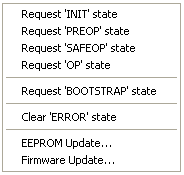
Now one can select one of the "Request 'xxx' state" menu items to set the device into a different state.